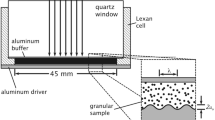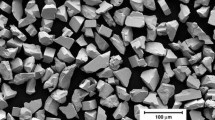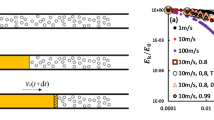Abstract
The propagation of uniaxial-stress planar shocks in granular materials is analyzed using a conventional shock-physics approach. Within this approach, both compression shocks and decompression waves are treated as (stress, specific volume, particle velocity, mass-based internal energy density, temperature, and mass-based entropy density) propagating discontinuities. In addition, the granular material is considered as being a continuum (i.e., no mesoscale features like grains, voids, and their agglomerates are considered). However, while the granular material is treated as a (smeared-out) continuum, it is recognized that it contains a solid constituent (parent matter), and that the structurodynamic properties (i.e., Equations of State (EOS) and Hugoniot relations) of the granular material are related to its parent matter. Three characteristic shock loading regimes of granular material are considered and, in each case, an analysis is carried out to elucidate shock attenuation and energy dissipation processes. In addition, an attempt is made to identify a metric (a combination of the material parameters) which quantifies the intrinsic ability of a granular material to attenuate a shock and dissipate the energy carried by the shock. Toward that end, the response of a typical granular material to a flat-topped compressive stress pulse is analyzed in each of the three shock loading regimes.






Similar content being viewed by others
References
L. Davison, Fundamentals of Shock Wave Propagation in Solids, Springer, Berlin, Heidelberg, Germany, 2008
S.P. Medvedev, S.M. Frolov, and B.E. Gel’fand, Attenuation of Shock-Waves by Screens of Granular Materials, J. Eng. Phys. Thermophys., 1990, 58(6), p 714–718
J. Bakken, T. Slungaard, T. Engebretsen, and S.O. Christensen, Attenuation of Shock Waves by Granular Filters, Shock Waves, 2003, 13(1), p 33–40
A.B. Sawaoka, Dynamic Consolidation of Non-Oxide Ceramic Powders, Physica B, 1986, 139–140(3), p 809–812
A.H. Shen, T.J. Arhens, and J.D. O’Keefe, Shock Wave-Induced Vaporization of Porous Solids, J. Appl. Phys., 2003, 93(9), p 5167–5174
M.V. Muniz, H. Sobral, and R.N. Gonzalez, Shock and Thermal Wave Study of Laser-induced Plasmas in Air by the Probe Beam Deflection Techniques, Meas. Sci. Technol., 2003, 14, p 614–618
J.R. Rempel, D.N. Schmidt, J.O. Erkman, and W.M. Isbell, Shock Attenuation in Solids and Distended Materials, Stanford Research Institute, Report No. AD0628796, 1965.
R.F. Trunin, K.K. Krupnikov, G.V. Simakov, and A.I. Funtikov, Shock-Wave Compression of Porous Metals, High-Pressure Shock Compression of Solids VII—Shock Waves and Extreme States of Matter, Springer, New York, p 177–195, 2004.
R.R. Boade, Principal Hugoniot, Second-Shock Hugoniot, and Release Behavior of Pressed Copper Powder, J. Appl. Phys., 1970, 41(11), p 4542–4551
M.F. Ashby, Material Selection in Mechanical Design, 3rd ed., Butterworth-Heinemann, 2005.
M. Grujicic, V. Sellappan, T. He, N. Seyr, A. Obieglo, M. Erdmann, and J. Holzleitner, Total Life-Cycle Based Materials Selection for Polymer Metal Hybrid Body-In-White Automotive Components, J. Mater. Eng. Perform., 2009, 18, p 111–128
M. Grujicic, G. Arakere, V. Sellappan, A. Vallejo, and M. Ozen, Structural-response Analysis, Fatigue-life Prediction and Material Selection for 1 MW Horizontal-axis Wind-Turbine Blades, J. Mater. Eng. Perform., 2010, 19(6), p 780–801
M. Grujicic, G. Arakere, X. Xie, M. LaBerge, A. Grujicic, D.W. Wagner, and A. Vallejo, Design optimization and Material Selection for a Femoral-Fracture Fixation-Plate Implant, Mater. Des., 2010, 31, p 3463–3473
M. Grujicic, X. Xie, G. Arakere, A. Grujicic, D.W. Wagner, and A. Vallejo, Design-Optimization and Material Selection for a Proximal Radius Fracture-fixation Implant, J. Mater. Eng. Perform., 2010, 19(8), p 1090–1103
R.G. McQueen, S.P. Marsh, J.W. Taylor, J.N. Fritz, and W.J. Carter, The Equation of State of Solids from Shock Wave Studies, High Velocity Impact Phenomena, R. Kinslow, Ed., New York, Academic Press, 1970, p 293–417
Acknowledgments
The material presented in this article is based on work supported by the Office of Naval Research (ONR) research contract entitled “Elastomeric Polymer-By-Design to Protect the Warfighter Against Traumatic Brain Injury by Diverting the Blast Induced Shock Waves from the Head”, Contract Number 4036-CU-ONR-1125 as funded through the Pennsylvania State University. The authors are indebted to Dr. Roshdy Barsoum of ONR for continuing support and interest in the present work. The authors would also like to thank Dr. Lee Davison whose book “Fundamentals of Shock Wave Propagation in Solids” and specifically Chapter 11: Porous Solids, provided the motivation and the necessary shock-physics background used in the present work.
Author information
Authors and Affiliations
Corresponding author
Appendix: Strong-Shock Temperature Hugoniot
Appendix: Strong-Shock Temperature Hugoniot
The procedure described in this appendix enables calculation of the temperature Hugoniot from the known stress/pressure Hugoniot for the granular material in the strong shock regime, as well as for its parent material. First, the Rankine Hugoniot equation is defined as:
and differentiated to get:
Then, the following expression for the combined First and Second Law of Thermodynamics along the Hugoniot:
is combined with Eq A.2 to eliminate \( {\frac{{{\text{d}}\upvarepsilon^{(H)} \left( v \right)}}{{{\text{d}}v }}} \) and get:
where \( \kappa \left( v \right) = p^{{\left( {\text{H}} \right)}} \left( v \right) - p^{ - } + \left( {v^{ - } - v } \right)\;{\frac{{{\text{d}}p^{{\left( {\text{H}} \right)}} \left( v \right)}}{{{\text{d}}v }}}.\)
To obtain the temperature Hugoniot, \( \upeta^{{\left( {\text{H}} \right)}} \left( v \right) \) must be eliminated from Eq A.4. Toward that end, the total derivative of the temperature is defined using the known thermodynamic derivatives (Ref 1) as:
or
using Eq A.4, (Eq A.6) becomes
Equation A.7 is a first-order ordinary differential equation (ODE) in the quadrature format (since its second term is a product of a function of the independent variable v and the dependent variable, \( \uptheta^{{\left( {\text{H}} \right)}} \left( v \right) \). These types of ODE’s are integral in a disguised format and can be readily integrated. The integrated form of Eq A.7 is given in Eq 15.
Rights and permissions
About this article
Cite this article
Grujicic, M., Pandurangan, B., Bell, W.C. et al. Shock-Wave Attenuation and Energy-Dissipation Potential of Granular Materials. J. of Materi Eng and Perform 21, 167–179 (2012). https://doi.org/10.1007/s11665-011-9954-8
Received:
Published:
Issue Date:
DOI: https://doi.org/10.1007/s11665-011-9954-8




